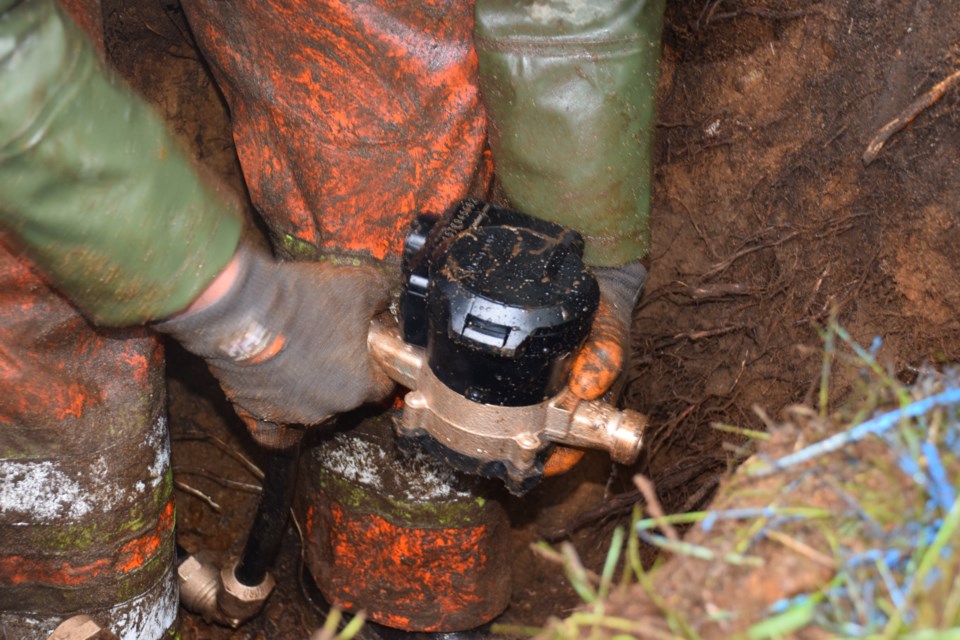Unexpected depths and non-conforming pipes in Sechelt will cost the regional district an additional $2.6 million.
The budget for Sechelt water meter installations will bump up to $12 million, as endorsed at a May 22 Sunshine Coast Regional District (SCRD) committee of the whole meeting. Neptune Technology Group Canada Co.’s contract for installation will rise to $10.8 million.
“Metered connections are a vital step in support of leak detection and also metered billing,” said Jesse Waldorf, manager of capital projects, at the meeting.
Around 84 per cent of the approximately 4,222 service connections in Sechelt are done, said a staff report, but it’s the most challenging and complex installations that remain: deep, multi-user and non-conforming meters.
Breaking down the costs
The largest chunk of change, just over $1.9 million is to install about 390 meters for very deep connections, which will require machine excavation and other measures. (Some excavations could get 18 feet deep, the committee heard. “Whoever thought it was a good idea to bury a water pipe 18 feet deep,” Elphinstone director Donna McMahon mused.)
Second, $1.3 million will go toward about 50 large multi-family or strata “master meters.” (Multi-user service connections were excluded from the original contract, said staff.)
Finally, about $642,000 is for a “substantial amount” of non-conforming meters, connections, or installs.
When the project started, staff had to make assumptions about depth, size and locations of service connections, as many were originally installed by third parties, like developers, said a staff report. Since installations started, the contract has changed to accommodate broken or non-conforming water meters and non-standard service connection sizes. A meter for a two-inch pipe is triple the cost for a one-inch pipe connection, shared staff at the meeting. “Things were installed in the past without SCRD oversight, as we would do it now,” said general manager of infrastructure services, Remko Rosenboom.
Increased archaeology-related costs also contributed to the increased price tag (that contract was increased by $255,068 in December, but didn’t amend the overall project budget).
“Staff have examined options such as re-tendering the work or performing it in-house, relocation of some of these deeper meters inside, but each of these alternatives results in a delay in completion of the project and increased risks or liability on part of the SCRD,” said Waldorf. He said amending the current contract is the “most direct and lowest risk way” to ensure the project is done on-time, all in support of getting volumetric billing in line.
The vast majority of leaks –– in volume and number –– have been between the meter in the street and the person’s home, said Waldorf.
The budget includes a 15 per cent contingency.
Borrowing already approved
The $12 million total can be covered by $6 million in borrowing (already elector authorized) and $6 million in available grant funding, said the report.
The effects of the $2.6 million budget boost would amount to $22.20 per parcel per year in the "Regional Water Service Area," according to the report.
The meter installations, which started in 2023, are scheduled to be done in Q3 of this year.
Zone meters
Asked if there’s metering along the main water lines, Rosenboom said there aren’t what are called “zone meters.” The SCRD can identify leaks by rate of filling or depletion of reservoirs. “If something is draining really rapidly, then we know that something is going away somewhere.”
While the SCRD is looking into zone meters in future years, “once we have some of the more urgent things under control” as they can be an efficient tool in leak identification and operational improvement, it’s a costly endeavour. Because the water mains are usually 12 inches or bigger, meters can cost $100,000 or more, shared Rosenboom.
Leaks detected
Since water meter installation started, the SCRD has addressed nine leaks of “significant” volume ––– which were losing a total of about 450,000 litres per day –– and since January, it has identified two leaks that accounted for the loss of 123,000 litres of water a day, according to Rosenboom. The only leaks they’re so far resolving are those where the meter is installed and “immediately starts spinning,” said Rosenboom.
“We haven't done any water meter reads yet, so we don't know exactly how much water is currently leaking within the Sechelt area…but based on the data we have so far, we expect there will be a substantial amount,” said Rosenboom.
While directors weren’t enthused to spend the funds, they appeared resigned to passing the budget increases before them. “We're kind of going to have to bite it,” said Halfmoon Bay director Justine Gabias, noting that they’ve seen such budget rises in other water projects, such as the Church Road Well Field. Following her comments, committee discussed and passed a resolution seeking staff insights into how much water the metering has saved as a tool in justifying the budget increase to the public.
The board still needs to confirm the committee resolutions.



